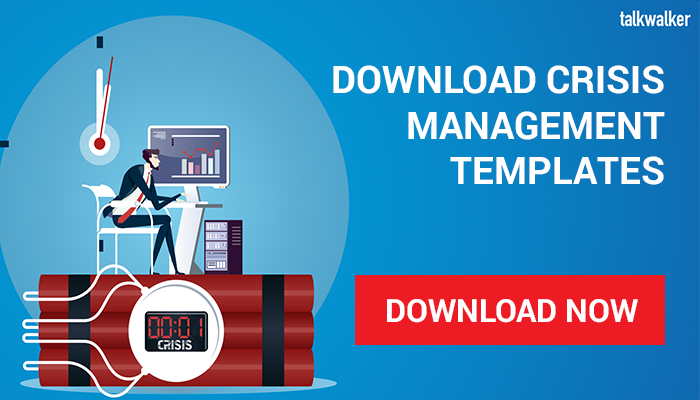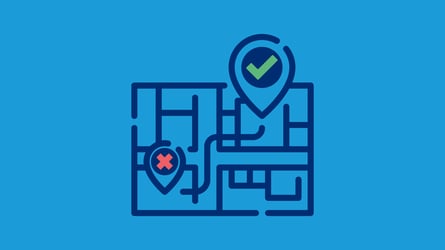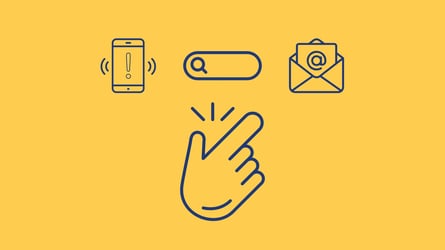I'm going to tell you how... Plus, to help you deal with a crisis, download two free crisis management templates. The roadmap you navigate if a crisis strikes, and a checklist in case of emergency.
DOWNLOAD FREE CRISIS MANAGEMENT TEMPLATES
Size is not important, you need a crisis management plan
Large or small, businesses need a crisis management plan. Because, let’s be honest, it’s not IF it happens, it’s WHEN.
It might be a teeny-weeny blip on Facebook that can be resolved with a painless quick fix. Or, it could be a code red on your suite of social media accounts that needs the full crash team. Both detrimental to your reputation, both requiring crisis management.
Not sure you need to read a crisis management guide? Think you've got everything under control? Don't believe me...
"You know my interest in Digital PR crisis management by now. I’ve written extensively on it and it’s a chapter in my new book for the public sector, but here is a great guide from Talkwalker." @tweetsbyJSB
Social media listening tools can save your life, tuning into chatter about your brand, your industry, your competitors. Enabling you to catch a potential crisis early and be proactive. You’ll have the tools to stop a crisis becoming the kind of social media disaster that’s included in a top ten blog post about PR Disasters.
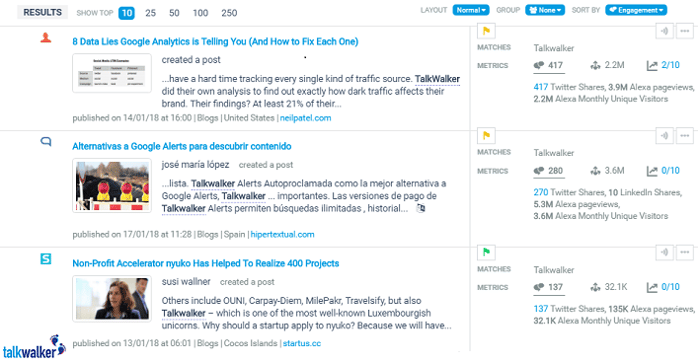
When you find a potential crisis emerging, you need to work through your crisis management checklist. This should include:
- Identifying the type and severity of the crisis
- Electing you crisis management team - include contact details
- Creating your internal communication plan
- Setting up the approval process for messaging
- Agreeing pre-approved messages - keep automated responses to the minimum, you’re human
- Defining your social media policy
Table of contents
BEFORE THE CRISIS
1. Choose your crisis management team
2. Who has keys to your social media accounts?
3. Choosing the right tools
4. Practice makes perfect
DURING THE CRISIS
5. What should you be monitoring?
6. Warning signals
7. Be transparent, be upfront
8. How to identify the type of crisis
9. How to escalate and respond to a crisis
AFTER THE CRISIS
10. What does best practice crisis management look like?
11. Conclusion
What is crisis management?
Crisis management - prevention/reputation/risk management - includes prepared scenarios meant to help an organization tackle a sudden and powerful negative situation. While an increasing number of brands appreciate the importance of having a crisis management plan, according to communications services company Burson-Marsteller, only 51% have one. With only one-third of those companies having faith in their plan working.
Regardless the type of crisis you’re heading towards, your reaction time must be fast to minimize potential damage to your brand. Your crisis (A.K.A. risk) management plan has to include more than just a scheduled press conference - that just won’t wash in the online world we now live in. A thorough crisis plan must include social media, internal comms, supply chains, vendors, and the press. Best practices include:
- Listing the risks you think may threaten your brand or company
- Adopting monitoring systems - such as Talkwalker - to detect and monitor early warning signs of crises
- Setting up and briefing the crisis management team
- Outline of response and resolve tactics
- Establishing levels of responses depending on the strength of the crisis
An effective response model includes a system for categorizing and prioritizing issues, and details the appropriate response for each type. Here’s a sample response model:
- Level one - impact unknown
Watch and monitor with social media listening, to check for developments. If necessary, respond to negative comments. Try to move the conversation to DM. - Level two - important but routine issue
You’ve found negative mentions on your social channels that are gaining traction. If your company messed up or caused the situation - put your hands up immediately, and apologize. - Level three - all hands on deck response
This is a code red situation, you need to respond immediately. The impact on your customers and brand is high. Task your crisis team with fixing the issue, and employ a social listening tool to find mentions so you can respond with updates.

1. Choose your crisis management team
When you see signs of a major crisis heading your way, it’s all hands on deck. Your crisis management plan should have a list of team members that you may need to call upon before, during, and after a crisis. Include all their contact details: email, phone number, mobile - during the working day, and out of hours.
For instance, depending on the crisis, include HR, PR, legal, support, account managers, marketing. It’s important to establish who the decision maker is. This person will be accountable for managing the team, the crisis, and working with the CEO for resolution.
2. Who has keys to your social media accounts?
Scenario #1
Sophie had a great weekend. She had a few cocktails, went dancing with her mates, took some selfies. How do I know? She forgot to switch from her personal account and tweeted from the company one.
In 2017, Francoise Nyssen - the French Culture Minister - had her Twitter account hacked by the son of her community manager. The 13-year old tweeted insulting and inappropriate messages that when found, caused many red faces and were swiftly deleted.
J'imagine la tête des premiers du @MinistereCC qui vont s'apercevoir des dégâts causés cette nuit... pic.twitter.com/pWidHclW0X
— Thomas Jarrion (@thomas_jarrion) July 18, 2017
Scenario #2
Harsh but true, Sophie was fired. She didn’t bother to switch from the company account to her personal one, and let everyone know how she felt about losing her job.
In 2013, entertainment retailer, HMV, laid off 190 members of staff. The company - other things on its mind, presumably - lost control of its Twitter account and during an angry revolt, seven tweets were posted.
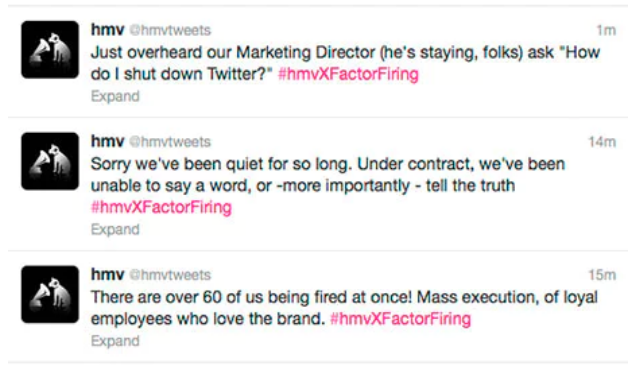
No surprise, all the original tweets were deleted.
Limit access to carefully chosen community managers who can be trusted to avoid these kind of mistakes.
3. Choosing the right tools
Yes, having a code red team is vital. Taking responsibility and being transparent, should be the norm. Apologizing like a human rather than a bot, c’mon, that’s obvious. But, none of this matters if you don’t have the best tools for the job.
Choose your tool wisely, preferably one that provides the following features - and more - under one roof:
- Real-time alerts - you can set up Talkwalker Alerts, but to avoid major crises you'll need a more robust analytics tool - such as Talkwalker.
- Image recognition - research shows that up to 80% of pictures shared online, don't bother to reference visible brands in the accompanying text. Our image recognition technology identifies these posts so you as a brand can protect your trademark against misuse and abuse.
- Sentiment analysis - or opinion mining, reveals what consumers think of your brand, product, or event. This AI tech finds opinions online and scores them positive, negative or neutral. Our sentiment analysis technology captures customer sentiment with 90% accuracy, understanding the meaning of full sentences, and able to accurately determine customer attitudes and contextual reactions in tweets, posts, and articles. You can also amplify messaging that’s receiving positive engagement, while responding appropriately to negative comments.
- Support for multiple languages - the buzz around your brand is global. Talkwalker’s social listening platform supports 187 languages, so it can identify where your customers are, how they’re communicating, and what they’re saying.
- Business impact metrics - track and assess the impact to your business during/following crises. Use automated reporting to collect insights and share with all team members.
Reuters published an article covering Oprah’s speech at the Golden Globes. Talkwalker was referenced as tracking the social media mentions surrounding her speech. Our social listening platform monitored the virality - in this instance, positive.
If you can find a tool that has monitoring, listening, and analyzing all in one place, your response time will be accelerated. Detecting and managing crises will be painless.
4. Practice makes perfect
You’re in a code red crisis situation. Good time to test the validity of your crisis plan?
Seriously, put it to the test before it’s needed. Identify gaps in your process and confirm or modify roles and responsibilities. Test under normal and unusual circumstances. During working hours, out of hours, and another when a key player in your crisis team is out of office. Unfortunately, issues don’t always happen when you’re sat in front of Twitter with your support team leader sat beside you.

5. What should you be monitoring?
Social media is your life, your job.
Constantly watching, it's probably you that sees the early warning signals of an impending crisis. A social listening tool is your best friend - the eyes in the back of your head, your second set of ears. It will monitor specific keywords, mentions, hashtags, sentiment.
To protect your brand, create queries to monitor your company, brand, products, competitors, etc. Ensure you include common variations, spelling errors, slang - I've included queries that Coca-Cola could use:
- Company name
The Coca-Cola Company OR Coca-Cola Company OR Coca-Cola Co. OR The Coke Company - Products and/or brands
Coca-Cola OR Cola OR Coke OR coca cola OR Diet Coke OR Coke Light Or Coca Lite - Competitors
Pepsi OR PepsiCo OR Dr Pepper OR drpepper - Hashtags
#shareacoke OR #cokestyle - Key players - CEO, CMO, etc
Jane Smith OR J Smith OR JPSmith - Industry keywords
beverage industry OR soft drinks industry OR soda industry OR sugary drink OR fizzy drink - Crisis buzz words
obesity OR sugar OR tooth decay - Influencers
- Support inquiries
- PR representatives
DOWNLOAD CRISIS MANAGEMENT FLOWCHART
6. Warning signals
There are always telltale signs when a crisis is heading your way, and in our always on world, social media is where they tend to strike first. As a human, you’ll recognize many of the signs. But, you won’t see them all.
Setting up smart alerts in your social listening tool, will detect the warning signs you miss. You’ll go beyond the limitations of human ears and eyes and find:
- An increase in mentions
- Negative comments outweighing positive
- Complaints about competitors
- Negative industry rumblings
- Sudden spikes or drops in activity around your brand
- Dodgy use of your logo with image recognition
- A peak in negativity with sentiment analysis
- Influencer mentions in news streams, blogs, forums, social media
January 3, 2018 - Tesla received the usual amount of negativity, nothing to worry about.
Relax, snooze time. WTF! A spike in negative sentiment.
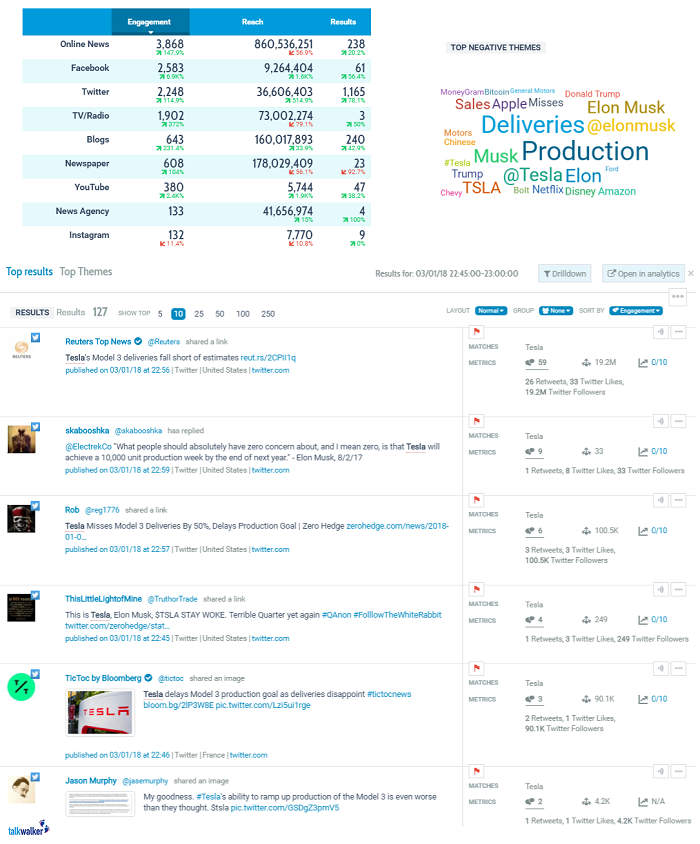
Drilling down, the source of negativity becomes clear. It sprung from an article in Reuters, highlighting a delayed production target - the second delay - of the new Model 3 sedan.
With Tesla falling short of Wall Street expectations and letting down its investors, finding and addressing this negative mention, meant that Tesla dodged a larger crisis.
7. Be transparent, be upfront
- Set the right expectations
Not all companies are able to offer real-time support 24/7. That’s fine, but be honest with your customers. If they know you’re tucked up in bed, they’ll be more inclined to wait and less likely to post a negative comment. Imply that you’re always online, and customers will be all over you like a rash. - Create moderation guidelines
You’ve got T&Cs on your website, you should have moderation guidelines on your social media accounts. Let people know what you will and won’t tolerate. If you’re clear about your house rules, they won’t be too surprised when you delete offensive posts.Example - “We ask that when contributing your views to our social media pages, you ensure that they do not abuse, threaten, discriminate, or offend others - otherwise they will be deleted. Please protect the personal privacy of your own and others by not publicly posting personal information.”
- Face up to it
Don’t be one of those companies that deletes or ignores posts that you don’t like or agree with. And never, ever, ever pretend that your account has been hacked, rather than putting your hands up and accepting responsibility. We’re gonna think you don’t care. - Respond thoughtfully
Be honest, be genuine, be sorry, and resolve the issue quickly. Hey, we’re human, we mess up. Customers just want to be treated right. Don’t just bang out a response without thinking, with mistakes and obvious lies. Talk to the customer one to one, be polite, win them round.69% of customers check out reviews before contacting a business, with 72% trusting reviews. Keep this in mind, when you consider ignoring or hiding bad reviews. You'll be missing out on an easy way to engage with your audience.
- Remember, it’s not personal, it’s business
Customers can be wrong, customers can say and do stupid things. But, they pay the bills. Never be rude or attacking when you’re engaging with them - be Captain Cooltastic.
8. How to identify the type of crisis
Identifying a crisis at an early stage can play heavily on the final outcome and your ability to solve it successfully.
- Level one - self-inflicted
This is all down to the company - bad practice, carelessness, hiring the wrong people, angry ex employee, or a bad customer experience. Usually initiated with a leak of information or a public attack. - Level two - unanticipated data error
This could be financial or a technical data error. An unintentional error that can quickly go viral online, with potentially damning consequences. In 2010, Google accidentally gathered extracts of personal Web activity from domestic WiFi networks through its Street View cars. A public apology and explanation was posted on the Google’s blog. - Level three - public misinformation
I guess, this could also now be called #FakeNews. It’s inaccurate information coming from outside the company. Could be a misguided politician, for instance.
Just out according to @CNN: "Utah officials report voting machine problems across entire country"
— Donald J. Trump (@realDonaldTrump) November 8, 2016
A little known Republican nominee tweeted that Utah officials had reported problems with voting machines across the country. CNN later corrected this misinformation - the problem was across the county NOT country - (facepalm).
-
Level four - outside force
Some problems come from outside the company. For instance, when third parties hacked into Equifax portals - a consumer credit reporting agency that collects data from 800M+ consumers and 88M businesses worldwide. Blamed on a failure to patch a software vulnerability, the data of over 145 million consumers was compromised. Data that included social security numbers, birth dates, and driver’s license numbers.
IN CASE OF EMERGENCY - DOWNLOAD THE 13-STEP CRISIS PLAN CHECKLIST
9. How to escalate and respond to a crisis
It’s all about how fast you can respond with a clear, honest, transparent answer. And, the solution. Do this well and you can turn online complaints into a boosted online reputation, with positive publicity.
- Choose the most appropriate channels on which to communicate with your audience
- React superfast. Research demonstrates that the success of customer service is often determined by speed of reaction, more than anything else
- Evaluate the gravity of the issue and respond directly to those affected by the crisis first
- Give constructive responses to questions, requests, or complaints. Prove you care
- You must be genuine, human. Show your commitment to solving your customers’ problems
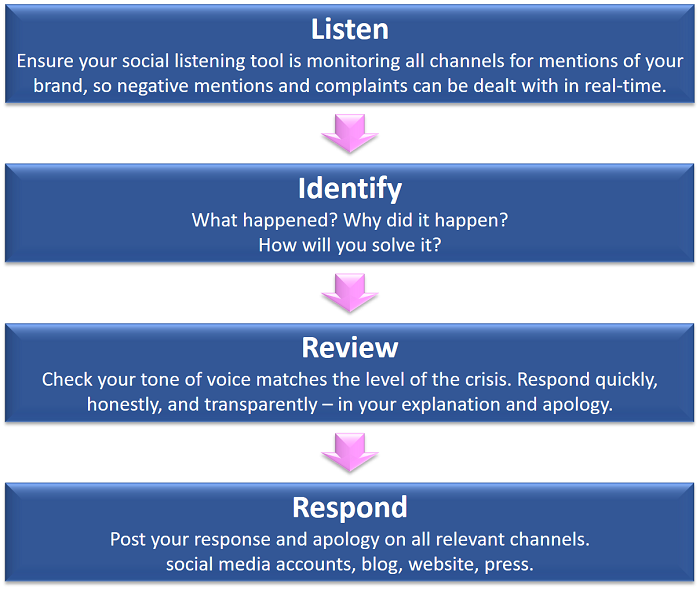

10. What does best practice crisis management look like?
Greggs, a UK bakery chain, suffered as the result of an online prank. When searching for Greggs, the Google results page displayed a fake logo with an offensive slogan - “providing s*** to scum for over 70 years.” Gregg’s social media team was flooded with comments. Naturally, the team alerted Google to the issue.
Hey @GoogleUK, fix it and they're yours!!! #FixGreggs pic.twitter.com/d5Ub7qtrLG
— Greggs (@GreggsOfficial) August 19, 2014
Gregg’s social media team’s response demonstrated sheer brilliance.

With Google playing along.
In November 2017, team collaboration tool Slack, went down. Not a crisis caused by the social media team, but they were responsible for dealing with the fall-out. They kept it light, playful, and updated constantly.
We're sincerely sorry for the service disruption you're seeing at the moment. We're working on it with top priority: https://t.co/hlhV4ZiG7E
— Slack (@SlackHQ) October 31, 2017
In 2013, Lululemon Athletica - sports attire brand - suffered Pants-Gate. Black yoga pants had to be recalled because they were - unintentionally and unexpectedly - see-through. The brand, while suffering a drop in stock prices, demonstrated a strong crisis management plan. The brand:
- Admitted its mistake and offered refunds or exchanges
- Responded with humility and openly laughed at itself - We want to be transparent with you
- Issued press releases stating the facts
- Posted FAQs on its website
- The CEO communicated with the press directly
- Worked with their brand ambassadors to keep them happy
Lululemon's see-through pants problem causes stock to drop, also severe disappointment in guys who always take back row in yoga class.
— Lauren (@LaurenGoode) March 19, 2013
Even the negative comments, saw the funny (back)side.
11. Conclusion
Let’s recap…
BEFORE THE CRISIS
- Build a crisis team
- Define a crisis
- Establish your key message
- Define communication guidelines
- Monitor for mentions
DURING THE CRISIS
- Regain control
- Stop scheduled posts - “Our product’s great.” Oops, it broke
- You can’t hide, so put your hands up and publicly acknowledge
- Get your crisis team on the case
- Post an official response on your company website - depending on the level of the crisis
AFTER THE CRISIS
- Assess impact on your brand - lost followers, negative sentiment, etc
- Talk through your response and plan - did it work? Could it be improved? Update plan
- It doesn’t stop when the crisis ends. Continue to be proactive and post updates
DONE
- Breathe!
We all make mistakes.
If you have a thorough crisis management plan in place, you’ll be ready to tackle reputational risks to your brand, quickly, honestly, and effectively. You’ll protect trust in your brand and prove that you care about your customers. Play it right, and you’ll turn that frown upside down :)
To help you deal with a PR crisis strategy, download two free crisis management templates. The roadmap you navigate if a crisis strikes, and a checklist in case of emergency.



